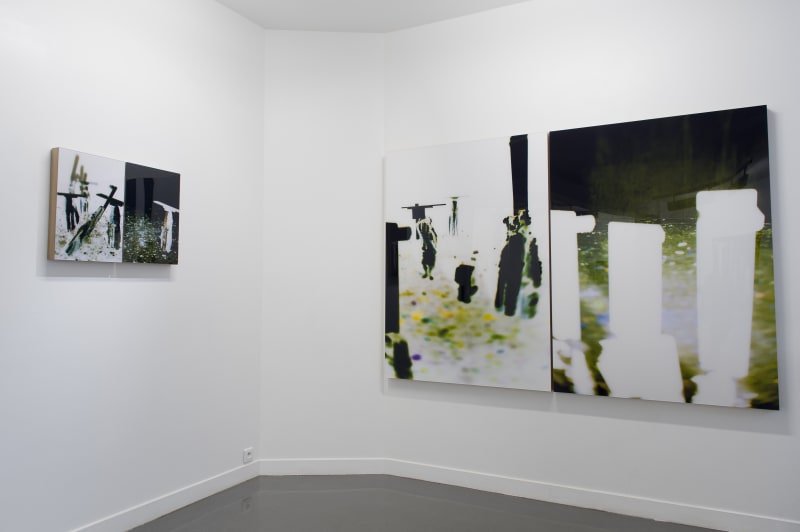The dazzled blind
For at least a century, if we go back to Dada and avant-garde cinema frames, in the field of experimental photography absolute freedom has reigned. Not that artists have been latching on to photographic technique in an irreverent, anarchical way, they have just not been keeping to the order of the images. Experimental photography does not fit in with the logic of reproducibility of the world, each time it launches a fresh attempt at making one from scratch. The work of Thibault Hazelzet falls in this category.
The recent series titled La Parabole des Aveugles (the parable of the blind) sounds like a homage to the well-known painting by Bruegel. But given the optical experiment it proposes, it in turn takes on the shape of a parable on sight and the jeopardy facing those deprived of it. However, Thibault Hazelzet’s blind are not metaphors for ignorance, still less for the conformist attitude that leads us towards the cliff edge. What we initially make of it refers back to a world of shadows and primitive shapes plunged in irradiated night. To try and come close to it we need to forget the title for a moment, and blind ourselves in order to approach these polyptychs, of which there is only one, thereby distinguishing in an immediate, non-theoretical way the difference here between number and the multiple.
As a painter by training, an adventurous visual artist happy to try his hand at sculpture and installation art, photography is not a discipline for Thibault Hazelzet. But at the same time he states plainly that the work is there: in these variable Diasec mounted formats, the result of a recording made with a view camera. So it is not so much photography per se as “photographic work”. What is to be made out is unmistakably the product of a lens. You will find it has types of aberration such as blurriness and distortions, which are a part of our visual culture. So “things” have indeed been recorded but without any desire to watch them having been implemented. Such technical casualness bordering on negligence with respect to the optical system is due to a deeper intention: Thibault Hazelzet does not change his lenses to meet any particular need, he acts in a pragmatic and intuitive way, adjusting or misadjusting depending on the point that he wants to show in focus, or on the contrary depending on the areas he wishes to leave fuzzy. He has a sensual approach to the camera lens. Talk to him about lighting, you will get the same answer: he is not looking for any effect through the lighting of his things, although he knows that you can obtain whatever effect you like. Ultimately, for Thibault Hazelzet, photography is never as good as when it is reduced to a kind of archaic use: an optical impression.
This way of working with photography by no means rules out complex operations or the sense of meticulous exploitation of the resources offered by the actual material of this medium. Thibault Hazelzet is good at setting up devices that work against the visual order. In earlier series, and again here, the artist takes several pictures on the same sensitive film. These multiple exposures are carefully calculated and thus combine several records on a single surface, in a layering of optical material. This precision tinkering is foreign to the resources available nowadays in terms of computer-generated imagery, as if manipulation, in the literal sense of handiwork, were indeed necessary. Thibault Hazelzet also likes to play with the positive and negative of the photographic image. Here he finds a mode of dialogue between the spaces. Now digging deep through darkness, now pinning down in intense light, he unfolds and turns values upside down, thereby adding graphic power to the expressiveness of the optical aberrations. In the end, the spectator is made to face a viewing experience verging on bedazzlement, but of a kind that can be interrupted—not to bring it to a stop, but on the contrary to turn it into a representation.
La Parabole des aveugles would thus itself be a form of blindness. But we nonetheless need to describe what is perceptible in it and is preserved by the dazzle: some awkwardly geometrical structures tottering in this shadow theatre. They appear now close now distant, we can make them out but without being sure of our ability to see them perfectly. This army of defeated forms resembles the one that a might be recorded by a thermal camera, an X-ray machine or some other sophisticated wave scanning equipment.
As to the fact that we are here in the studio, before real wooden and plaster sculptures set on the floor the way fetishes would be, we know nothing apart from what the artist is willing to tell us. These beings have been the subject of an odd sacrifice that has turned them into a series of optical sculptures. They are the blind restored to the light.
Michel Poivert
Translation by John Lee

